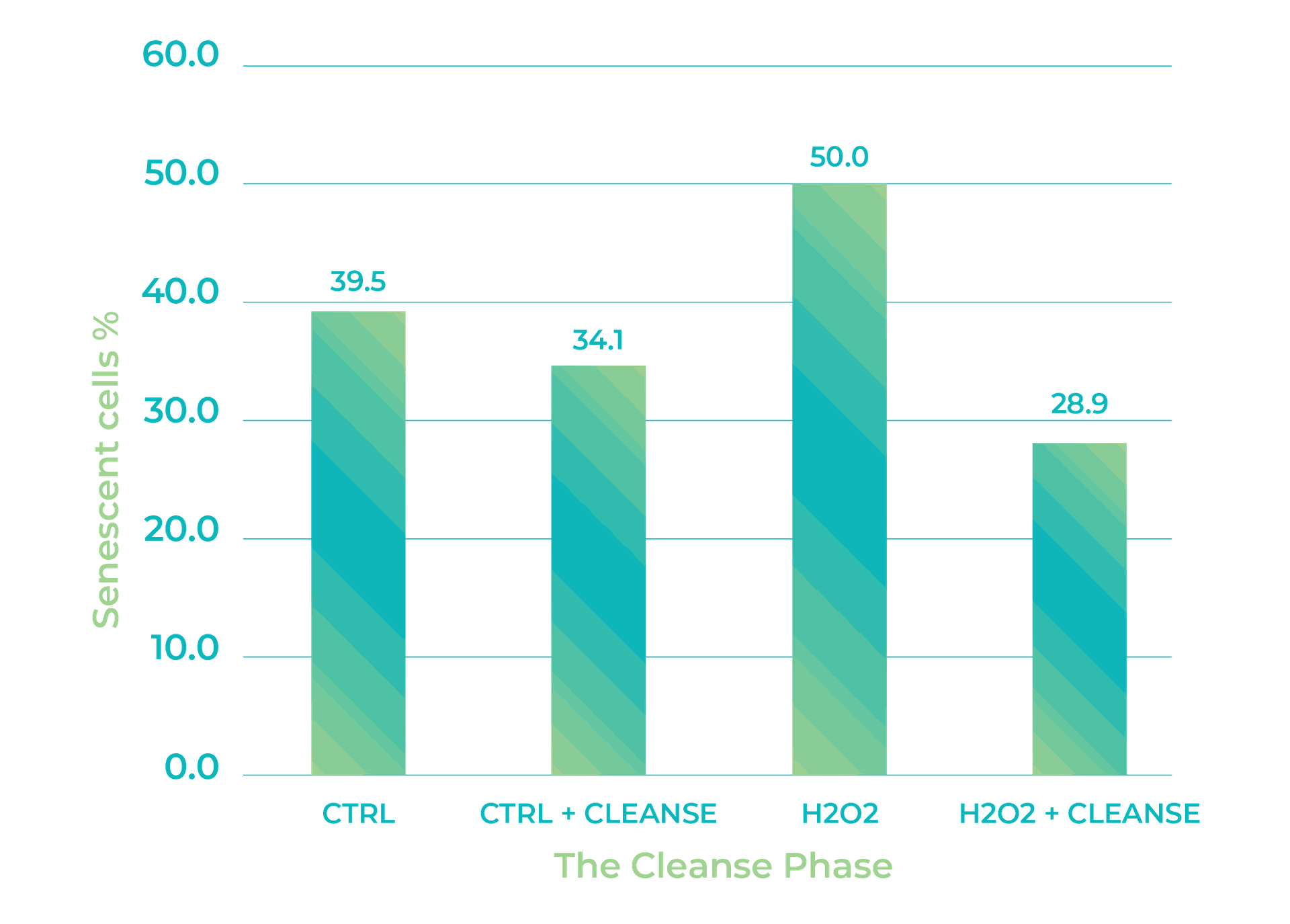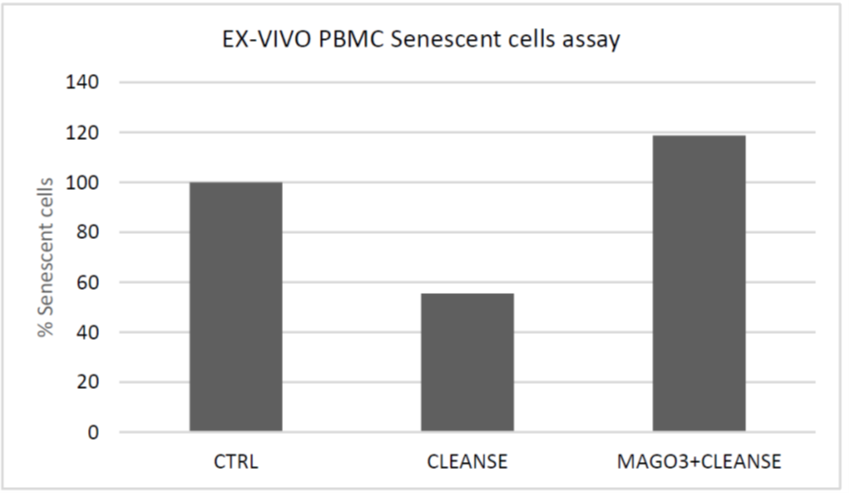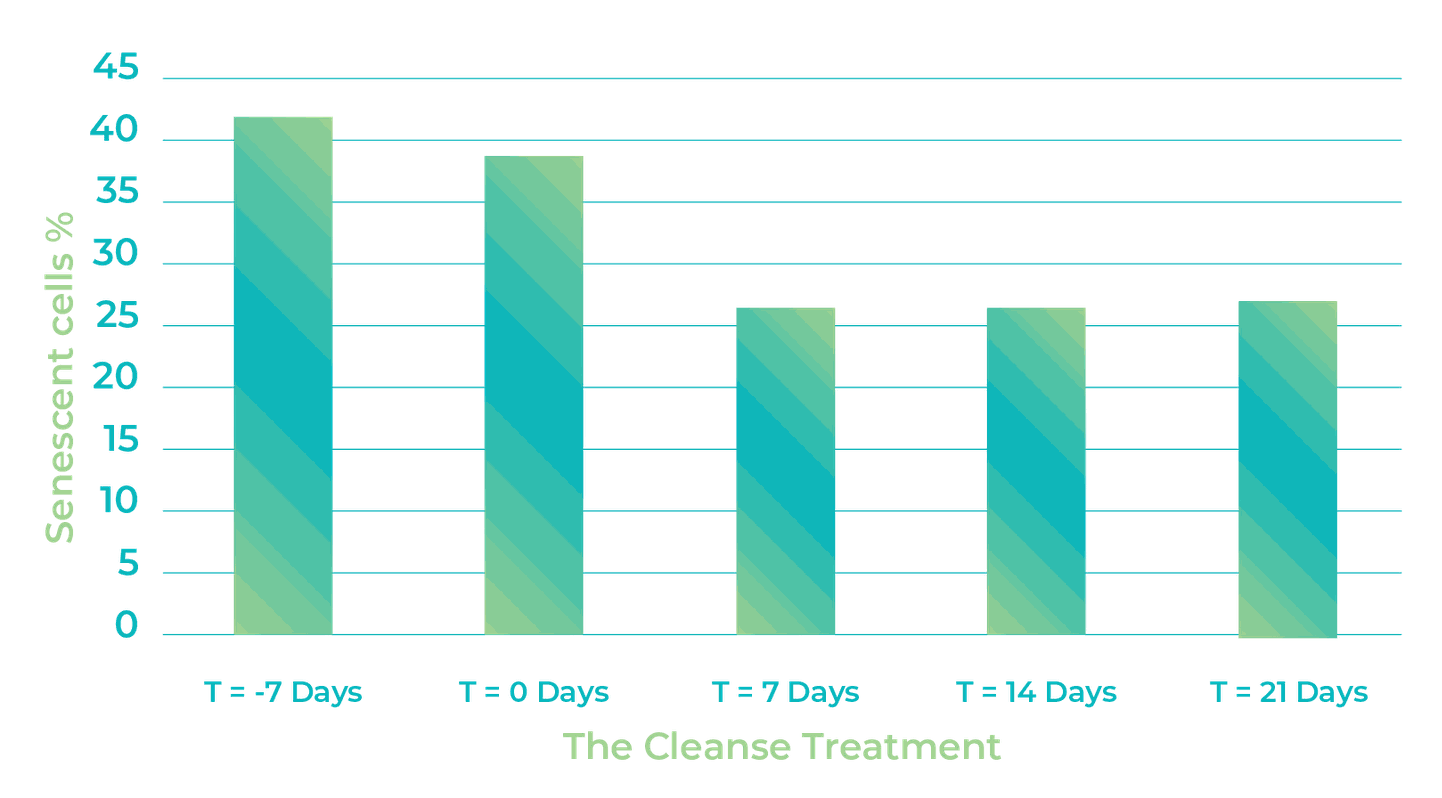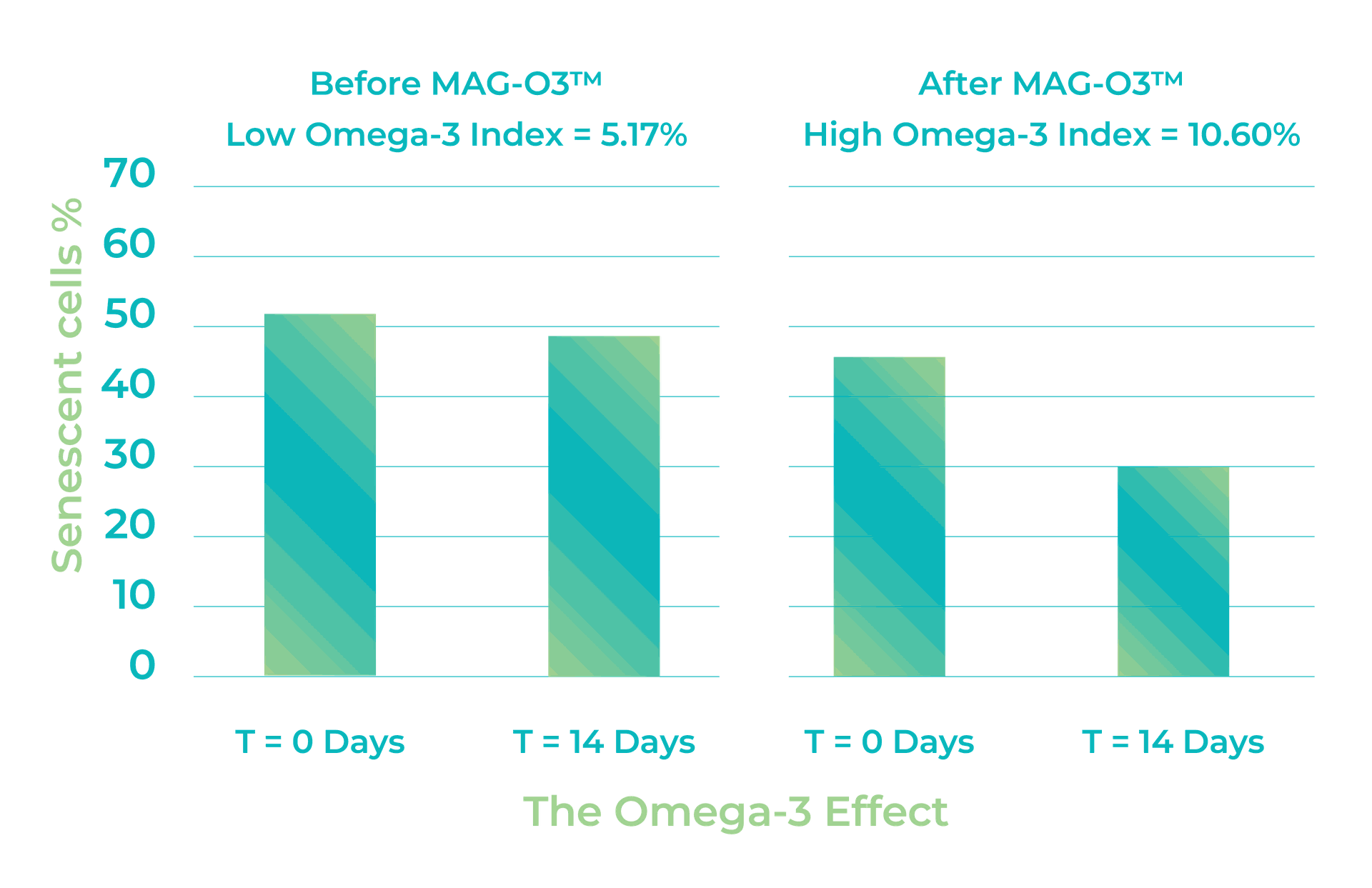Introduction
The modern health-conscious individuals seek more than just longevity; the aspiration is to age gracefully, maintaining vitality and vigor as the years go by. In this pursuit, the groundbreaking realm of cellular senescence and senolytics offers incredible promise [1,2]. EB Supplements™ , leveraging proprietary and cutting-edge research and development, presents a meticulously crafted two-step senolytic program designed to optimize cellular health and combat the negative impacts of aging.
The Cellular Menace: Senescent Cells
In the complex process of aging, one of the most significant challenges faced is the presence and impact of senescent cells, often colloquially referred to as "zombie cells." These cells represent a unique state in the cellular lifecycle where, despite losing their normal proliferative and functional abilities, they continue to exhibit metabolic activity. Unlike typical healthy cells, senescent cells do not follow the usual path of apoptosis or cellular death; instead, they linger within tissues and accumulate over time.
One of the primary concerns with senescent cells is their secretion of various inflammatory substances. These substances can be harmful to surrounding cells and tissues, creating a local environment characterized by inflammation and cellular stress. This phenomenon is known as the Senescence-Associated Secretory Phenotype (SASP) and includes the release of pro-inflammatory cytokines, chemokines, growth factors, and proteases [3,4]. The SASP not only affects neighboring cells but can also contribute to systemic aging and the development of age-related diseases.
The accumulation of senescent cells is a significant factor in the progression of various age-related diseases and conditions. Research has linked the presence of these cells to the development of chronic diseases such as osteoarthritis, atherosclerosis, and neurodegenerative diseases [5]. Moreover, their presence is implicated in the decline of physical function and resilience in aging individuals. As these cells accumulate, they can disrupt normal tissue structure and function, leading to a gradual deterioration in health.
Given the detrimental effects of senescent cells, managing their accumulation is a vital aspect of promoting healthy aging. The elimination or reduction of these cells has the potential to mitigate the inflammatory environment they create, possibly slowing down or reversing certain aspects of the aging process [6-10]. By targeting these cells, it is possible to enhance longevity and vitality, contributing to a healthier, more active lifespan.
This understanding of the role of senescent cells in aging has led to the development of various strategies and therapies aimed at reducing their impact [11]. These include the use of senolytic agents that selectively target senescent cells, and other approaches aimed at modulating the SASP or enhancing the body's natural ability to clear these cells [12]. The ongoing research and development in this field are crucial in our quest to understand and effectively manage the aging process, ultimately leading to improved health outcomes for aging populations.
Complementing Senescent Cell Management with Autophagy Enhancement
Following the targeted management of senescent cells, another critical component in the complex aging process is the maintenance of cellular health through the promotion of autophagy. This natural, regulatory mechanism serves as a cellular housekeeping tool, systematically degrading and recycling damaged cellular components. Such activity is indispensable for the regeneration of new, healthier cells, thereby preserving cellular integrity and functionality, crucial aspects of longevity and overall cellular health [13].
Autophagy is particularly vital as a defense against various cellular stresses, including oxidative damage, nutrient scarcity, and the build-up of dysfunctional proteins and organelles. Its role in clearing these deleterious components is essential in preventing cellular dysfunction, a common feature in aging and associated diseases [14]. The decline in autophagy efficiency with age underscores the need for strategies to sustain or even enhance this process [15].
The significance of autophagy extends well beyond simple cellular maintenance. Emerging research indicates that augmenting autophagy can considerably extend longevity. This enhancement could be instrumental in mitigating the impacts of accumulated cellular damage and the proliferation of senescent cells, potentially decelerating elements of the aging process [14].
In the realm of anti-aging research, stimulating autophagy has become a focal point. This includes exploring dietary, lifestyle, and pharmacological approaches capable of activating this vital cellular process. Such interventions are being examined not only for their potential to bolster cellular health but also for their broader implications in aging and age-related disease prevention[16].
Therefore, in the pursuit of healthy aging, a dual-pronged approach is essential: one that involves the strategic elimination of harmful senescent cells and another that nurtures beneficial cellular mechanisms like autophagy. This balanced strategy is pivotal in developing a comprehensive framework for age management, aiming to enhance both the quality and longevity of life.
EB Supplements™ Innovative and Patent Pending Two-Step Approach

Figure 1. Patent-pending EB Supplements™ Two-Phase Senolytic Program
Phase I : Eliminating Excess Zombie Cells
Duration: 2 weeks
Dietary Supplement Product:
EB Supplements™ Healthy Aging Senolytic Cleanse
Guided by Dr. Samuel Fortin, whose expertise in omega-3 and cellular health is well-recognized, EB Supplements™ has developed a strategic method to address cellular aging. Phase I of this innovative approach is underpinned by Dr. Fortin's ex-vivo research, which has provided critical insights into the effectiveness of natural and well recognized senolytic agents such as Fisetin, Quercetin, and EGCG [17-19]. His empirical studies have revealed the capabilities of a proprietary blend of those specific senolytics (The Cleanse) to substantially lower the percentage of senescent cells.
Ex-Vivo Research Study 1: The Impact of EB Supplements' Senolytic Cleanse on Senescent PBMCs
In his pivotal Ex-Vivo Study on Senolytics and Senescent PBMCs, Dr. Fortin utilized human peripheral blood mononuclear cells (PBMC) from healthy donors. These cells served as the foundation for assessing cellular senescence through a metabolic assay based on β-galactosidase fluorescence. The study's design involved the induction of senescence using hydrogen peroxide (H2O2), a well-known oxidative stressor. This model demonstrated an elevation in senescence markers which was greatly mitigated by "The Cleanse", showcasing the blend's potential as a dietary supplement against PBMC senescence (Figure 2).

Figure 2. Dr. Fortin's Initial Ex-Vivo Study - The Impact of EB Supplements' Senolytic Cleanse on Senescent PBMCs.
Ex-Vivo Research Study 2: Interaction between MAG-O3™ and The Cleanse blend
In a critical follow-up study, Dr. Fortin examined the interplay between "The Cleanse" senolytic blend and MAG-O3™, an Omega-3 supplement. Unexpectedly, this combination led to an increased proportion of senescent cells, suggesting a potential biochemical interaction when senolytics are combined with omega-3 fatty acids (Figure 3). While "The Cleanse" alone brought senescent cell levels down to 58%, introducing MAG-O3™ escalated levels to 119%. This pivotal finding prompted the strategic decision to discontinue concurrent administration of senolytics and Omega-3 supplements in future interventions.
 Figure 3. Dr. Fortin's Second Ex-Vivo Study on the Interaction of MAG-O3™ and The Cleanse Blend
Figure 3. Dr. Fortin's Second Ex-Vivo Study on the Interaction of MAG-O3™ and The Cleanse Blend
Case Study 1 : Marked reduction in senescent PBMCs after long term supplementation of "The Cleanse"
In the subsequent exploration of "The Cleanse" and its impacts on cellular aging, Dr. Fortin embarked on a meticulously designed case study to further investigate the senolytic efficacy of the blend. The objective was to closely observe and quantify the reduction of senescent Peripheral Blood Mononuclear Cells (PBMCs) over a defined period, providing concrete data on the performance of "The Cleanse."
The methodology involved a 48-year-old Caucasian male volunteer who ceased his Omega-3 supplementation for seven days before commencing a 21-day regimen of "The Cleanse" without any Omega-3 support. Blood samples were collected at specified intervals—T=-7, 0, 7, 14, and 21 days—to isolate PBMCs and assess their senescence levels through a B-galactosidase fluorescence cell-based assay.
The results, as depicted in Figure 4, were telling. A substantial decline was observed a week into the regimen (T=7 days), where senescent cell levels dropped to 27%. From there, the reduction in senescent cells plateaued, maintaining at 27.5% at two weeks (T=14 days) and slightly rising to 28% by the third week (T=21 days).

Figure 4. Case Study 1: Over a three-week period, using "The Cleanse", there was a marked reduction in senescent PBMCs
This case study corroborated the potential of "The Cleanse"—a specialized blend of Fisetin, Quercetin, and EGCG—in effectively diminishing the percentage of senescent PBMCs. The data affirmed that a two-week period is adequate for achieving the maximum senolytic effect, suggesting that the 'hit-and-run' model of treatment, where senescent cells are targeted in short, potent bursts, is a viable approach for senolytic intervention. These insights are invaluable for the ongoing pursuit of effective dietary intervention in the field of age-related research and for individuals looking to proactively manage the aging process.
Utilizing this knowledge, the EB Supplements™ Healthy Aging Senolytic Cleanse was developed. For a span of two weeks, individuals are subjected to the power of "The Cleanse", aiming to target and eliminate excess senescent cells, allowing the body to regain its natural cellular balance.
Phase II : Repair and Rejuvenate
Duration: 4 months
Dietary Supplement Products:
EB Supplements™ Healthy Aging Autophagy: Cell Maintenance
EB Supplements™ Healthy Aging MAG-O3™ Daily Omega-3
The Phase II of EB Supplements™'s program builds upon the successful reduction of senescent cells, transitioning towards nourishing and revitalizing the cellular landscape to promote a healthier, more vibrant physiological state.
The EB Supplements™ Healthy Aging Autophagy: Cell Maintenance is a sophisticated formulation designed to support and enhance the body's intrinsic repair mechanisms. This product is imbued with a blend of the following scientifically backed ingredients: Nicotinamide mononucleotide (NMN), Luteolin, Resveratrol and Pterostilbene. Each of these ingredients were selected for their unique properties in fostering cellular health and promoting the process of autophagy as described below.
- Nicotinamide mononucleotide (NMN) is a precursor to NAD+, a molecule integral to numerous metabolic functions including the activation of pathways that encourage autophagy. Its modulatory effects on mTOR pathways and the protection it offers, especially to cells in oxygen-deprived heart tissue, are well documented [20]. Furthermore, clinical research suggests that NMN supplementation can increase nicotinamide levels, which may correlate with improvements in arterial stiffness—a significant factor in cardiovascular aging [21]. These insights reinforce the significance of NMN in bolstering NAD+ metabolism, underlining its potential as a supportive agent for cellular vitality and an ally against the aging process.
- Luteolin, a flavonoid found in many plants, enhances AMPK activation and inhibits mTOR, promoting autophagy [22]. Beyond its role in cellular maintenance, luteolin exhibits extensive anticancer effects, influencing cell proliferation, apoptosis, and autophagic processes. Its use alongside traditional anticancer agents may amplify treatment efficacy and reduce side effects. Its poor water solubility leads to bioavailability challenges which a natural delivery system such as MAG-O3 could potentially help alleviate. Ongoing clinical trials aim to further establish its anticancer potential [23].
- Resveratrol, a polyphenolic compound found abundantly in grapes, has been documented to activate autophagy across various in vivo and in vitro models. Its interaction with metabolic sensors/effectors like mTOR, AMPK, and SIRT1 elucidates its role in modulating metabolic and mitochondrial functions, thereby contributing to cellular health [24].
- Pterostilbene (PT), a resveratrol derivative with improved bioavailability, demonstrates significant anti-inflammatory and anticancer properties. In addressing Non-Alcoholic Fatty Liver Disease (NAFLD), PT activates the AMPK/mTOR pathways and autophagy, particularly through Nrf2 activation, effectively reducing lipid accumulation in hepatocytes and managing oxidative stress [25]. In hepatocellular carcinoma (HCC) research, PT significantly impairs the viability and proliferation of HepG2 liver cancer cells. It induces apoptosis, evident from biochemical and cellular changes such as reduced lipid peroxidation and increased caspase-3 activity. PT also modulates key proteins like mTOR and p53, essential for cell survival, highlighting its potential in steering cancer cells towards programmed cell death[26]. This dual action of PT, in both autophagy regulation and apoptosis induction, positions it as a valuable ingredient in supplement formulations aimed at enhancing cellular health and combating cancer.
In Phase II of the EB Supplements™ program, MAG-O3™ Daily Omega-3 plays a crucial role in enhancing cellular repair and rejuvenation post-cleanse. While omega-3 fatty acids are known for various health benefits, their role in aging support through autophagy has recently been explored. Studies indicate that omega-3 PUFA supplementation enhances autophagy following traumatic brain injury (TBI), inhibiting neuronal apoptosis and offering neuroprotective effects. [27].
Case Study 2 : Enhanced Senolytic efficacy after MAG-O3™ Supplementation
Moreover, another more recent study from Dr. Fortin demonstrated that pre-treatment with MAG-O3™ improves the Senolytic Cleanse's effectiveness. The case study assessed the impact of prior Omega-3 supplementation on the efficacy of "The Cleanse" in reducing senescence in PBMCs. It showed only a marginal reduction in senescent cells with "The Cleanse" taken with no prior MAG-O3 supplementation and low omega-3 index level (Figure 5). However, after elevating the Omega-3 index with MAG-O3™ supplementation, a subsequent "The Cleanse" regimen led to a notable decrease in senescent cells. This suggests that enhancing the Omega-3 index beforehand may boost the effectiveness of the senolytic treatment.

Figure 5. Enhanced Senolytic efficacy after MAG-O3™ Supplementation: Dr. Fortin's Second Case Study.
The inclusion of EB Supplements™ Healthy Aging MAG-O3™ Daily Omega-3 serves a dual purpose. As evidenced by Dr. Fortin's studies, this monoglyceride omega-3 rich fish oil aids in optimizing the efficacy of the Cleanse Phase (Phase I) while enhancing the Autophagy process.
By combining EB Supplements™ Healthy Aging Autophagy and MAG-O3™ Daily Omega-3 supplements , EB Supplements™ offers a robust approach to the second phase of healthy aging—repair and rejuvenation. This four-month period focuses on consolidating the gains achieved in the initial phase and setting the stage for efficacious subsequent cleansing phase and sustained cellular health and functionality.
Conclusion: Navigating the Path to Proactive Aging
In the vast landscape of health and wellness, EB Supplements™ stands out, merging cutting-edge research with tangible, proactive solutions. Their two-step patent pending [28] senolytic program embodies this approach – first tackling the issue of cellular senescence head-on and then nourishing the body to restore optimal cellular function.
With a foundation rooted in science, spearheaded by the insights of Dr. Fortin and backed by the innovative prowess of EB Supplements™, individuals now have a roadmap to healthier aging. Join EB Supplements™ in this pioneering journey towards comprehensive well-being, where each year is met with grace, vitality and vigor.
References
-
O’hara K, Mullen M, Oberlohr V, Hambright S, Huard J, Duke V. Poster 125: Determining Biological Age and Prolonging the Healthspan by Targeting Senescence. Orthop J Sports Med. 2022;10(7 suppl5):2325967121S00686. Published 2022 Jul 28. doi:10.1177/2325967121S00686
-
Zhang L, Pitcher LE, Prahalad V, Niedernhofer LJ, Robbins PD. Targeting cellular senescence with senotherapeutics: senolytics and senomorphics. FEBS J. 2023;290(5):1362-1383. doi:10.1111/febs.16350
-
Bhatia-Dey N, Kanherkar RR, Stair SE, Makarev EO, Csoka AB. Cellular Senescence as the Causal Nexus of Aging. Front Genet. 2016;7:13. Published 2016 Feb 12. doi:10.3389/fgene.2016.00013
-
Lopes-Paciencia S, Saint-Germain E, Rowell MC, Ruiz AF, Kalegari P, Ferbeyre G. The senescence-associated secretory phenotype and its regulation. Cytokine. 2019;117:15-22. doi:10.1016/j.cyto.2019.01.013
-
van Deursen JM. The role of senescent cells in ageing. Nature. 2014;509(7501):439-446. doi:10.1038/nature13193
- Demaria M, O'Leary MN, Chang J, et al. Cellular Senescence Promotes Adverse Effects of Chemotherapy and Cancer Relapse. Cancer Discov. 2017;7(2):165-176. doi:10.1158/2159-8290.CD-16-0241
- Schafer MJ, White TA, Iijima K, et al. Cellular senescence mediates fibrotic pulmonary disease. Nat Commun. 2017;8:14532. Published 2017 Feb 23. doi:10.1038/ncomms14532
- Childs BG, Baker DJ, Wijshake T, Conover CA, Campisi J, van Deursen JM. Senescent intimal foam cells are deleterious at all stages of atherosclerosis. Science. 2016;354(6311):472-477. doi:10.1126/science.aaf6659
- Jeon OH, Kim C, Laberge RM, et al. Local clearance of senescent cells attenuates the development of post-traumatic osteoarthritis and creates a pro-regenerative environment. Nat Med. 2017;23(6):775-781. doi:10.1038/nm.4324
- Thompson PJ, Shah A, Ntranos V, Van Gool F, Atkinson M, Bhushan A. Targeted Elimination of Senescent Beta Cells Prevents Type 1 Diabetes. Cell Metab. 2019;29(5):1045-1060.e10. doi:10.1016/j.cmet.2019.01.021
- Chaib S, Tchkonia T, Kirkland JL. Cellular senescence and senolytics: the path to the clinic. Nat Med. 2022;28(8):1556-1568. doi:10.1038/s41591-022-01923-y
- Kang C. Senolytics and Senostatics: A Two-Pronged Approach to Target Cellular Senescence for Delaying Aging and Age-Related Diseases. Mol Cells. 2019;42(12):821-827. doi:10.14348/molcells.2019.0298
- Mizushima N, Komatsu M. Autophagy: renovation of cells and tissues. Cell. 2011;147(4):728-741. doi:10.1016/j.cell.2011.10.026
- Wong SQ, Kumar AV, Mills J, Lapierre LR. Autophagy in aging and longevity. Hum Genet. 2020;139(3):277-290. doi:10.1007/s00439-019-02031-7
-
Barbosa MC, Grosso RA, Fader CM. Hallmarks of Aging: An Autophagic Perspective. Front Endocrinol (Lausanne). 2019;9:790. Published 2019 Jan 9. doi:10.3389/fendo.2018.00790
- Aman Y, Schmauck-Medina T, Hansen M, et al. Autophagy in healthy aging and disease. Nat Aging. 2021;1(8):634-650. doi:10.1038/s43587-021-00098-4
-
Yousefzadeh MJ, Zhu Y, McGowan SJ, et al. Fisetin is a senotherapeutic that extends health and lifespan. EBioMedicine. 2018;36:18-28. doi:10.1016/j.ebiom.2018.09.015
- Zoico E, Nori N, Darra E, et al. Senolytic effects of quercetin in an in vitro model of pre-adipocytes and adipocytes induced senescence. Sci Rep. 2021;11(1):23237. Published 2021 Dec 1. doi:10.1038/s41598-021-02544-0
- Kumar R, Sharma A, Kumari A, Gulati A, Padwad Y, Sharma R. Epigallocatechin gallate suppresses premature senescence of preadipocytes by inhibition of PI3K/Akt/mTOR pathway and induces senescent cell death by regulation of Bax/Bcl-2 pathway. Biogerontology. 2019;20(2):171-189. doi:10.1007/s10522-018-9785-1
-
Maiese K. New Insights for nicotinamide: Metabolic disease, autophagy, and mTOR. Front Biosci (Landmark Ed). 2020;25(11):1925-1973. Published 2020 Jun 1. doi:10.2741/4886
- Katayoshi T, Uehata S, Nakashima N, et al. Nicotinamide adenine dinucleotide metabolism and arterial stiffness after long-term nicotinamide mononucleotide supplementation: a randomized, double-blind, placebo-controlled trial. Sci Rep. 2023;13(1):2786. Published 2023 Feb 16. doi:10.1038/s41598-023-29787-3
- Ashrafizadeh M, Ahmadi Z, Farkhondeh T, Samarghandian S. Autophagy regulation using luteolin: new insight into its anti-tumor activity. Cancer Cell Int. 2020;20(1):537. Published 2020 Nov 4. doi:10.1186/s12935-020-01634-9
- Shi M, Chen Z, Gong H, et al. Luteolin, a flavone ingredient: Anticancer mechanisms, combined medication strategy, pharmacokinetics, clinical trials, and pharmaceutical researches. Phytother Res. Published online December 13, 2023. doi:10.1002/ptr.8066
- Pineda-Ramírez N, Aguilera P. Resveratrol as an inductor of autophagy: is there a unique pathway of activation?. Neural Regen Res. 2021;16(1):101-103. doi:10.4103/1673-5374.286959
- Shen B, Wang Y, Cheng J, et al. Pterostilbene alleviated NAFLD via AMPK/mTOR signaling pathways and autophagy by promoting Nrf2. Phytomedicine. 2023;109:154561. doi:10.1016/j.phymed.2022.154561
- Khalil MI, Agamy AF, Elshewemi SS, Sultan AS, Abdelmeguid NE. Pterostilbene induces apoptosis in hepatocellular carcinoma cells: Biochemical, pathological, and molecular markers. Saudi J Biol Sci. 2023;30(8):103717. doi:10.1016/j.sjbs.2023.103717
-
Chen X, Pan Z, Fang Z, et al. Omega-3 polyunsaturated fatty acid attenuates traumatic brain injury-induced neuronal apoptosis by inducing autophagy through the upregulation of SIRT1-mediated deacetylation of Beclin-1. J Neuroinflammation. 2018;15(1):310. Published 2018 Nov 8. doi:10.1186/s12974-018-1345-8
- Polyunsaturated fatty acid monoglycerides, compositions, methods and uses thereof. Patent Application: WO2023122827A1
EB Supplements™ Pioneering Two-Step Senolytic Program for Advanced Healthy Aging